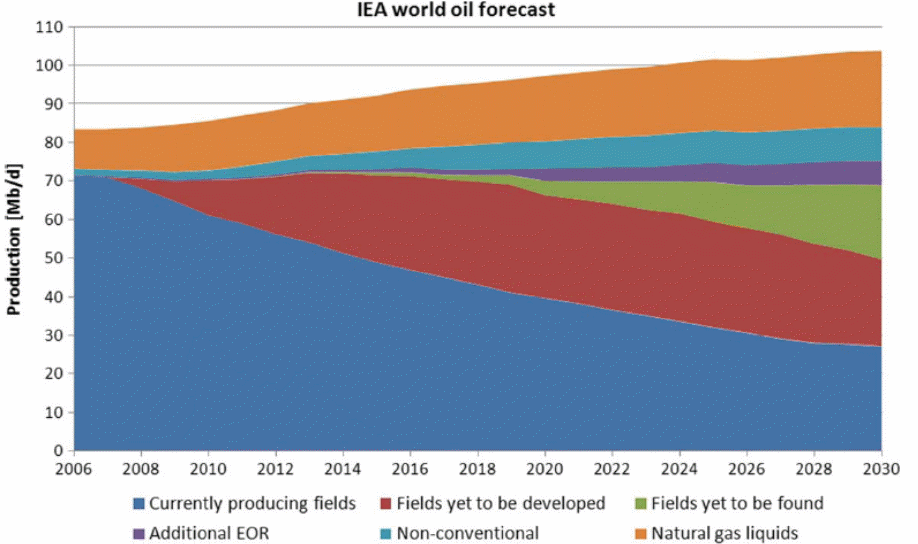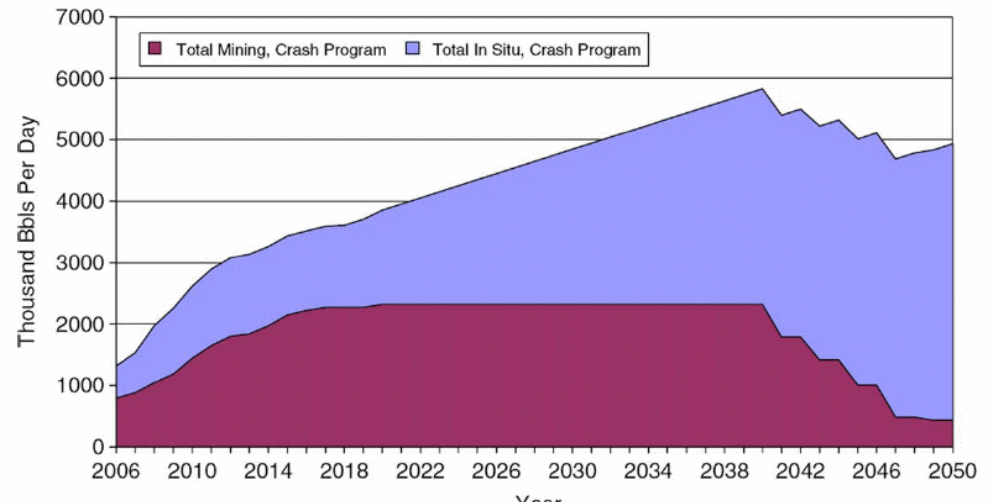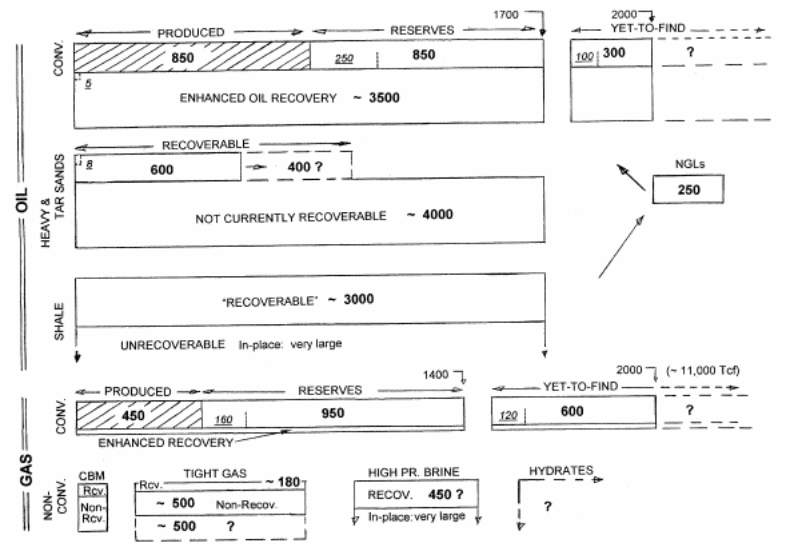Introduction
Bentley (2002) observes that the global supply of conventional oil will soon fall. The rationale here is that the total amount of oil produced globally (apart from the five major Middle East producers) has almost reached the optimal level on the basis of the physical resource boundaries. If the oil supply from the Middle East is considerably reduced, it will be impossible to replenish the supply of other oil-producing countries.
It is important to note that Middle East suppliers have limited operational capacity which could be explored when the global supply of conventional oil declines in other parts of the world. Nonetheless, even if considerable investments are introduced in the Middle East, resource constraints will eventually curtail oil supply from this region. Consequently, the global supply of conventional oil will significantly decline in the next 20 years (Bentley 2002, p. 189).
However, the existence of different oil substitutes, as well as the presence of enormous quantities of non-conventional oil, demonstrates that suppliers will have the ability to cover and supply enough oil so that the oil will not peak in 20 years. It is against this background that the current report will be based on the analysis of the oil supply settings that form the core of the World Energy Outlook 2008. Figure 1 presents potential situations that could be exploited to fulfill future oil supply.
Non-conventional oil
The International Energy Agency (IEA) describes non-conventional oil as chemical additives, coal-to-liquids, gas-to-liquids, extra-heavy oil, and oil sands. A report by the World Energy Outlook (2008) reveals that non-conventional oil is projected to rise from 1.6 Mb/d (as of 2007) to 8.7 Mb/d by 2030. This is a significant rate of growth (8% per annum) when compared to the oil boom that occurred after the culmination of WWII.
Nonetheless, some scholars have demonstrated that the reduction in the supply of conventional oil (as a result of the peak oil decline) calls for a steady growth that exceeds 10 percent for non-conventional oil supply over the next 20 years (de Castro et al., 2009). Thus, the enormous potential of nonconventional oil cannot be ignored (see fig. 1). However, the industrial procedures needed to transform nonconventional oil into fluids expedient for transportation are quite dissimilar from the production of diesel, aviation fuel, bunker oil, and gasoline (from crude oil). It is worth mentioning that it is costly to extract these byproducts of unconventional oil. Therefore, higher extraction costs will definitely turn out to be a constraint in the extraction process (Aleklett et al., 2009, p. 1409).
Oil sand
Hirsch (2008) suggests that global mitigation strategies must be put in place in order to curb the potentially destructive impacts of peak oil. Some of the remedial measures suggested by Hirsch and colleagues include enhanced production of oil sand from Canada’s reservoir. In addition, the World Energy Outlook (2008) forecast that the product level from the oil sands will be approximately 5.8 Mb/d (comprising of 4.4 Mb/d from Situ and 1.4 Mb/d from mining).
What is more, the Canadian Association of Petroleum Producers (2008) predicts the future production of oil sand at between 3.7 Mb/d and 4.4 Mb/d by 2020. In comparison, Cambridge Energy Research Associates (2009) forecast two of their oil sand productions at 3 MB/d by 2030 (see fig. 2). The projections presented above seem to suggest that suppliers have the ability to cover and supply enough oil to prevent peak oil in the next 20 years.
Extra-heavy oil
The extra-heavy oil production in Venezuela is normally classified as non-conventional oil. Other planned extra-heavy oil production projects are found in Italy, Vietnam, and Brazil. Thus, the projected production of 0.7 Mb/d is somewhat reasonable. What is more, Kuwait has reviewed its production outlook for extra-heavy oil and now aims at 0.7 Mb/d by 2020 as opposed to the initial plan of 0.4 Mb/d. In the event that the prices of conventional oil increases, it is practical to predict that 0.7 Mb/d may still be attained.
Gas-to-liquids (GTL)
A report by the International Energy Agency (2008) offers projected production outlays of approximately $40-90/barrel, which is principally subject to gas price. What is more, the World Economic Outlook (2008) suggests that the planned projects will increase the GTL capacity from the current 0.2 Mb/d to approximately 0.65 Mb/d by 2030. However, Bentley (2002) suggests that the future production level of GTL will be lower than the projected figures due to the high costs of production. Nonetheless, the production forecasts by the International Energy Agency cannot be disregarded as unrealistic at this moment because the current supply of gas-to-liquid to total global oil supply is trivial.
Coal-to-liquids (CTL)
CLT has over the years been produced in selected countries under special conditions. For instance, South Africa is of the few countries to adopt this technique when it was under international sanctions. To date, the country is producing approximately 0.15 Mb/d of CTL. Nonetheless, it is important to note that it is extremely costly to undertake a CTL project. For example, Aleklett et al (2010) suggest that if the United States substituted a mere 10 percent of its transport fuel consumption with coal-to-liquid fuels it would need to produce approximately 240Mt of coal every year. In other words, the entire US coal reserves could be exhausted precipitately for the production of a small number of liquid fuels from CTL.
The resource base
Bentley (2002) suggests that there are various ways to counterbalance the drop in conventional oil supply. This can be achieved via (1) enhancements in oil retrieval factors; (2) improvement in liquid supplies from nonconventional oils (i.e. Biofuels, heavy oils, tar sand, oil from coal, and gas-to-gasoline) and; (3) using gas (rather than oil) for both transport and heating. Figure 3 describes the quantities of both conventional and non-conventional hydrocarbons with respect to a uniform scale. The following points can be inferred from the diagram:
- The bulky quantity of oil hypothetically existing to enhanced recovery.
- The usually-stated figures for the ‘recoverable’ segments of both Orinoco heavy oil and Athabasca tar sands (approximately 600 billion barrels) produce approximately 22 years of global demand.
- The enormous quantities of gas present in brine aquifers and deep reservoirs require further cost-benefit analysis prior to extraction.
The major point to mention from this figure is that nonconventional resources are present in large quantities. On the other hand, the recoverable resources (when weighed against the current extraction technologies) are rather difficult to extract (Bentley 2002, p. 194).
Rate of production
The major issue relating to non-conventional oil is the speed at which it can be supplied as conventional oil depletes. Bentley (2002) suggests that the worldwide supply of conventional oil will fall at approximately 2 Mb/d every year after the oil peaks. What is more, given that the global economy is on a steady growth pattern, the total supply from nonconventional and enhanced recovery oil must surge by approximately 4 million barrels per day every year in order to satisfy the current global demand.
Although this growth projection seems unfeasible, some studies (particularly on enhanced oil recovery) have demonstrated that the quantity of additional oil that can be accessible (within the timeframe relevant for worldwide peaking) will be somewhat small. The production in the United Kingdom offers an apt example where considerable strides have been made to augment recovery factors. What is more, the United States and Germany’s experiences reveal that improved oil recovery is only relevant once the oil peak has been reached (Bentley 2002, p. 195).
What is more, the supply of non-conventional oil in the future will be subject to a number of driving factors. These include carbon dioxide emissions, water requirements, investment resources, energy content, and technological preparedness.
It is important to note that these factors can potentially limit the ability to supply non-conventional oil on a global scale. For instance, a report by the International Energy Agency (1998) projected that it would require the production of approximately 19 million barrels per day of non-conventional oil in order to satisfy global demand by 2020. It is worth mentioning that the energy content is a major salient aspect of non-conventional oil. Therefore, caution must be observed especially when evaluating the usefulness of a crash project that aspires to augment nonconventional output to compensate for the decline in conventional oil supply (Bentley 2002, p. 195).
The bottom line
The main issue at hand relates to the fact of whether the world will completely deplete the existing conventional oil stock. Some scholars assert that this scenario is highly unlikely. Nonetheless, it is projected that conventional oil supply will ultimately become costly if lower-cost substitutes are not available. What is more, it is difficult to ascertain exactly when the global crude oil will peak because this will depend on a number of confounding factors such as the rate at which crude oil is demanded on a global scale.
What is more, the global demand rate will be affected by an increase or decline in technological innovation in oil product consumption (i.e. hybrid-enabled cars) as well as the existence of novel energy source technologies (i.e. Hydrogen-powered fuel cells). Furthermore, peak oil will be subject to the speed at which technological progress fast-track global development of non-conventional sources of crude oil (i.e. Heavy oils and tar sands). The future prospects look bright since there are some ongoing productions from a number of Venezuelan oil reservoirs and Canadian tar sands (Wood, Long & Morehouse 2003).
Conclusion
The conclusion that can be derived from the discourse above is that suppliers will have the ability to cover and supply enough oil to prevent the oil from peaking in 20 years’ time. For example, a number of countries are currently exploiting the possibility of producing non-conventional oil. South Africa is currently producing 0.15 Mb/d of coal-to-liquids. Venezuela is also engaged in the production of extra-heavy oils. Other planned extra-heavy oil production projects are found in Italy, Vietnam, and Brazil. All these activities indicate that oil suppliers will have the ability to supply enough oil in the next 20 years.
References
Aleklett, K, Hook, M, Jakobsson, K, Lardelli, M, Snowden, S & Soderbergh, B 2010, ‘The Peak of the Oil Age-Analyzing the world oil production Reference Scenario in World Energy Outlook 2008,’ Energy Policy, vol. 38, pp. 1398-1414.
Bentley, RW 2002, ‘Global oil & gas depletion: An overview’, Energy Policyvol. 30, pp. 189-205.
Cambridge Energy Research Associates 2009, Growth in the Canadian oil sands: finding the new balance. Web.
Canadian Association of Petroleum Producers 2008, Crude oil forecast, markets and pipeline expansions. Web.
De Castro, C., Miguel, L., Mediavilla, M 2009, ‘The role of nonconventional oil in the attenuation of peak oil’, Energy Policy, vol. 37, no. 5, pp. 1825-1833.
Hirsch, R 2008, ‘Mitigation of maximum world oil production: shortage scenarios’, Energy Policy, vol. 36, no. 2, pp. 881-889.
International Energy Agency 2008, World Energy Outlook. Web.
Wood, J, Long, G & Morehouse, D 2003, Long-Term World Oil Supply Scenarios. Web.
Appendix



